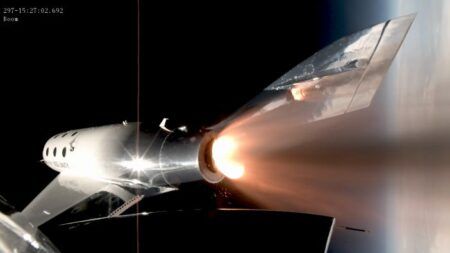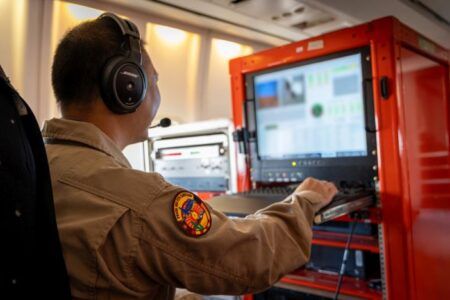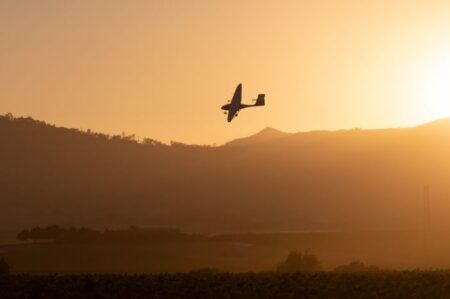For decades, high-speed photography has provided imagery for detailed analysis of stores separation tests. The principle behind the technique is to record multiple frames per second (fps) – as many as one million low-resolution images per second in some scientific and industrial applications – and then play these back at regular video rates of around 25fps, ‘stretching’ each second of recording over a much longer viewing period to produce slow-motion footage. Photron manufactures a huge range of high-speed digital cameras, and Andrew Bridges, sales and marketing director for Photron USA, says, only half jokingly, “We make high-speed cameras for slow-motion analysis.”
He goes on to provide a basic outline of high-speed camera technology, explaining that digital photography has revolutionized the industry. “The heart of any digital high-speed camera is the sensor. They’re not of particularly high resolution compared with a typical consumer camera – the high-end for us is 1080 HD – but the majority of our cameras are around one megapixel resolution. Nevertheless, they have as many as 128 channels to stream data off at very high speed.”
Data is buffered to an onboard memory, then downloaded post-mission. High-resolution images are generally not required for analysis, and even if they were, at high speeds it would be impossible to buffer to memory fast enough. “It’s typically the bottleneck,” says Bridges, “although it’s not so much of a concern in airborne applications. We have sensors specifically designed and engineered to our requirements at considerable cost, and since we don’t serve a mass market, high-speed cameras represent considerable investments.
We’ve migrated from CCD [close-coupled device] sensors to CMOS [complementary metal oxide semiconductor]. CCD suffered ‘blooming’, or ‘tearing’, so that if an aircraft turned, and the sun entered the frame, you’d end up with a column of white that would destroy any information in the column where the sun appeared. In CCD, black is created at 0V [zero volts] and white at 5V, and the problem was that electrons could overflow into neighboring pixels, corrupting the whole column. With CMOS, black is 5V and white is 0V, and since voltage can’t go below zero, we don’t have blooming or tearing problems anymore.”
The trials of separation
Airborne separation trials, especially from fast jets, naturally occur in a harsh environment of low temperatures, slipstream and, perhaps, high or negative g. Fortunately, digital high-speed cameras are inherently tough, given they have no moving parts. Even high-speed film cameras were capable of performing under harsh conditions of freezing temperatures at altitude or considerable vibration and delivering steady, well-exposed images at up to 1,000fps.
Photron builds ruggedized cameras for particularly harsh environments – “We do high-speed cameras that can withstand 100g and we do a lot of work for car crash testing” – while cameras used in airborne work are specially mounted. Converted missile bodies and modified drop tanks or similar pods are frequently used as camera containers in airborne work. Some cameras may also be equipped with a right-angle optic so that the body is arranged in line with the slipstream for minimal drag, or so that they will fit inside a long, narrow pod, while the lens looks out at 90°.
AOS Technologies’ high-speed camera range includes units built to military standards. CEO Stephan Trost says that fast jet stores separation testing produces the most severe environment for its cameras. He
notes, “These tests are expensive, so the cameras have to be reliable under these harsh conditions because a failure would be costly. The build and engineering is quite different to an industrial camera; the military cameras are built to our highest specification and independently lab-certified to military standards.”
Trost says that although modified pods or tanks are often used as camera housings, AOS offers alternatives: “We have containers that can be filled with nitrogen gas to avoid condensation and they also have window heating – it depends on what the customer wants. Often it comes down to the infrastructure available at the range or test site and what the test requires – it may even need multiple cameras.”
Interestingly, separation trials can be about more than weapons, as Trost describes: “Recently, we’ve done very different types of trial. We’ve worked with transport aircraft, filming decoy flares ejecting from their launchers. The trial was to ensure that they didn’t enter the engine intakes and that they followed the correct trajectories, recording at between 500fps and 1,000fps. We also did some work filming the separation of freight pallets, and we’ve placed cameras in UCAVs for trials into their flight performance.”
Dealing with data
Image manipulation has become an important facet of high-speed photography, offering choices in mounting configuration, since images can be mirrored or rotated. Less obviously, exposure can also be controlled, as Photron’s Bridges explains: “For explosive events or tests involving a missile plume, for example, the lighting changes very dramatically from one frame to the next, and we have the ability to ‘clip’ the exposure of every pixel. We set a time threshold of 20% in a one millisecond exposure for example, and if the pixel reaches its exposure within that threshold, we reset it and expose it again, so that instead of a bright flame whiting everything out, we capture a little more detail at a pixel-by-pixel level.”
Camera activation is typically integrated into the aircraft’s systems and linked to the firing or release mechanism as part of the flight test instrumentation. “With film cameras, you haveto
get the film up to speed and then there’s a finite amount of time before the film runs out. It might be possible to stop and start it a few times, but the acceleration and deceleration between events consumes film,” explains Bridges. “With digital, we can continuously overwrite the data, so in theory you could put the camera in ‘record’ mode before you took off and we could grab the few frames required for the event, or partition the memory into as many as 64 blocks, each of 1GB per event.”
Real-time telemetry
Discussing the possibilities for real-time telemetry from a high-speed camera, Stephan Trost says, “There’s no real-time datalink because it would jam the telemetry systems, but there is the option of a video output, from the same high-speed camera, that provides a live view during recording, via downlink to a ground station. Operators can also choose to see the camera status – is it buffering, how much memory remains, is it live recording? – on a screen on the ground.”
Modern high-speed cameras in airborne applications are typically small and light. Many applications, in scientific work for example, require a great deal of connectivity and functionality beyond the basics of the camera and memory, but these are not typical of airborne applications, which tend to require little more than power and a trigger. Such cameras therefore often weigh less than a kilogram, with perhaps a 7.5cm2 front cross-section and 10cm depth, depending on record time, resolution and specific test functionality. Three or four cables are all that is required to connect the camera to the wider system.
Paul E Eden is an aviation writer based in the UK




